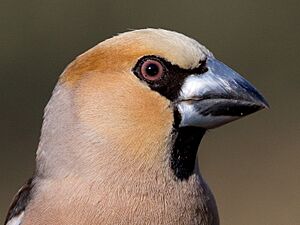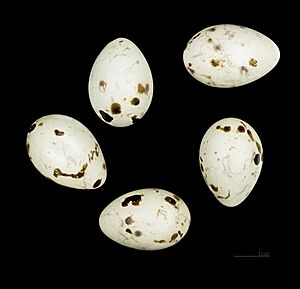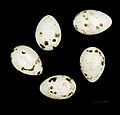Hawfinch facts for kids
Quick facts for kids Hawfinch |
|
|---|---|
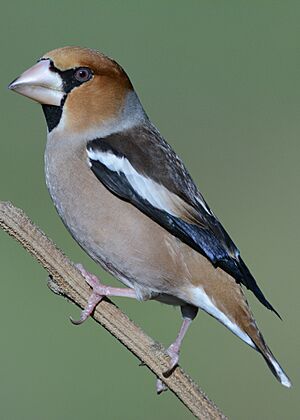 |
|
| Male in winter | |
| Conservation status | |
| Scientific classification | |
| Genus: |
Coccothraustes
|
| Species: |
coccothraustes
|
 |
|
| Ranges of C coccothraustes Breeding Resident Non-breeding | |
| Synonyms | |
|
Loxia coccothraustes Linnaeus, 1758 |
|
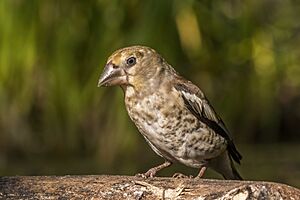
The hawfinch (Coccothraustes coccothraustes) is a cool bird that belongs to the finch family. It's the only bird in its special group, called Coccothraustes. This bird is known for its super strong beak!
Hawfinches live across Europe and parts of Asia. Many stay in Europe all year. But some Asian hawfinches fly south for the winter, like snowbirds! They sometimes even visit faraway places like Alaska.
These birds love forests with big trees, especially those with hornbeam trees. You might also spot them in parks. Hawfinches build their nests in bushes or trees. They usually lay 2 to 7 eggs. Their favorite foods are seeds and fruit pits, especially from cherries. They use their powerful beaks to crack these open. You'll often see these large finches in pairs or small groups.
The hawfinch is about 18 centimeters (7 inches) long. It's a chunky bird with a big head. When it flies, its tail looks very short. Its head is orange-brown with a black stripe around its eyes and a black patch under its chin. Its huge beak is black in summer and lighter in winter. The top part of its body is dark brown, and its belly is orange.
When a hawfinch flies, you can easily see the white stripes on its wings and the white tip on its tail. Male and female hawfinches look pretty similar. Their call sounds like a hard chick. The hawfinch is a bit shy, so its song is usually quiet and mumbled.
Contents
What's in a Name?
The hawfinch got its name a long time ago. A Swiss scientist named Conrad Gesner wrote about it in 1555. He used the Latin name Coccothraustes. This name comes from Greek words meaning "seed" (kokkos) and "to break" or "to shatter" (thrauō). This makes sense because of its strong seed-cracking beak!
Later, in 1758, a famous scientist named Carl Linnaeus gave it the scientific name Loxia coccothraustes. Then, in 1760, a French zoologist named Mathurin Jacques Brisson moved it to its own group, Coccothraustes. The English name 'hawfinch' was first used in 1676. 'Haws' are the red berries of the common hawthorn tree, which the bird likes to eat.
Scientists have studied the hawfinch's DNA. They found that it's closely related to other large-beaked finches called grosbeaks, like the Chinese grosbeak and the evening grosbeak. Even though some other finches also have big beaks, they aren't always close relatives. Sometimes, similar features develop because different animals eat similar foods.
Hawfinch Appearance
The hawfinch is about 18 centimeters (7 inches) long. Its wings can spread out between 29 to 33 centimeters (11 to 13 inches). It weighs about 46 to 70 grams (1.6 to 2.5 ounces). Males are usually a little heavier than females. It's a strong bird with a thick neck, a big round head, and a wide, powerful beak that looks a bit metallic. Its legs are short and pinkish, and it has a short tail. Its eyes are brown.
Female hawfinches are a bit lighter in color than males. The bird's main color is light brown, with an orange tint on its head. Its eyes have a black circle around them that extends to its beak. Its throat is also black. The sides and back of its neck are gray. The top parts of its wings are a deep black. Its wings also have three stripes: white, brown, and blue. Adult hawfinches change their feathers between July and September.
Where Hawfinches Live
Hawfinches live all over Europe, parts of Eastern Asia (like northern Japan), and North Africa (Morocco, Tunisia, and Algeria). They have been seen in Alaska, but that's usually by accident.
You won't find them in Iceland, some parts of the British Isles, or certain islands in the Mediterranean Sea. However, they do live in southern Europe, like Spain and Bulgaria, and in central Europe, including parts of England and southern Sweden. Since the 1950s, hawfinches have spread further north and can now be found as far north as Norway. In Asia, they live in places like the Caucasus, northern Iran, Siberia, and North Korea.
Hawfinches usually live in forests with trees that lose their leaves in autumn. They often choose fruit trees, like oak trees, especially when they are raising their young. They also visit places where people live, such as parks and gardens. You might find them in pine forests too, as long as there's water nearby. They can live at almost any height, as long as there are trees.
Hawfinches in the UK
A long time ago, in the 1700s, hawfinches were rare visitors to Britain in winter. They started breeding there in the early 1800s. By the 1830s, a group of them lived in Epping Forest near London. They continued to spread across England and even reached Scotland by the late 1960s. Their numbers were highest between 1983 and 1990. However, since then, their numbers have dropped quite a lot.
Today, most hawfinches in Britain live in southeastern England. Places like Bedgebury Pinetum and the New Forest are good spots to see them. They are also found in West Sussex and Surrey. In western England and Wales, you might find them in the Forest of Dean. In eastern England, they live in the Breckland area. In northern England, they are seen in places like Fountains Abbey and Hulne Park. You can also spot them at Scone Palace in Scotland. In Ireland, a small number of hawfinches visit every winter, often at Curraghchase Forest Park.
Hawfinch Life and Habits
The hawfinch is a shy bird, which makes it a bit tricky to watch. It spends most of its day high up in tree branches, especially when it's breeding. You'll usually only see it on the ground when it's looking for seeds or drinking water, and it always stays close to trees.
When it's eating or drinking, the hawfinch can be quite bossy. It will stand up to other birds, even bigger ones! When it has chicks, it protects a small area around its nest. But when it doesn't have young, it might protect a whole forest. This helps keep its young safe from predators.
Reproduction and Family Life
Hawfinches start having babies when they are about one year old. They usually have one partner, and sometimes they stay with the same partner for more than one year. They find their partners before the winter groups break up. The time they start breeding depends on how warm spring is. It's earlier in southern Europe and later in the north. In Britain, most eggs are laid between late April and late June.
Hawfinches have special ways of showing off to each other. They stand facing each other and gently touch their beaks. The male bird might puff up the feathers on his head, neck, and chest, and let his wings droop. Then he makes a deep bow. He might also lower a wing and move it in a half-circle to show off his pretty wing feathers.
Hawfinch pairs usually nest alone, but sometimes a few pairs will nest close together. The nest is usually high up in a tree on a flat branch that's easy to fly to. The male chooses the nest spot and starts building with dry twigs. After a few days, the female takes over. The nest looks a bit messy on the outside, made of twigs. But inside, it has a neat, shallow cup lined with roots, grasses, and moss.
The female lays eggs every day in the early morning. A normal clutch has 4 to 5 eggs. The eggs can look very different in color and shape. They might have purple-brown and light gray squiggles on a background that's buff, gray-green, or light bluish. The female sits on the eggs for 11 to 13 days to keep them warm.
Both parents feed the baby birds. They bring back seeds that they've partly digested, and also caterpillars. At first, the male often gives food to the female, who then feeds the chicks. But as the chicks get bigger, both parents feed them directly. The female stays with the chicks in the nest to keep them warm. The young birds leave the nest after 12 to 14 days. They become fully independent about 30 days later. Hawfinches usually raise only one group of babies each year.
It's interesting that the male hawfinch chooses the nest site and starts building. In most other finch species, the female does this. Also, hawfinch parents keep their nest very clean by removing the chicks' waste until they leave the nest. This is quite unusual for finches.
We don't know exactly how long hawfinches live in the wild. But one hawfinch in Germany was found to be 12 years and 7 months old!
What Hawfinches Eat
The hawfinch mainly eats hard seeds from trees and fruit pits. It uses its incredibly strong beak and powerful jaw muscles to crack them open. Its jaw muscles are so strong they can create a force equal to lifting about 30 to 48 kilograms (66 to 106 pounds)! This lets them easily break open cherry and plum pits. Other common foods include pine seeds, berries, new plant shoots, and sometimes caterpillars and beetles. They can even crack olive pits! Hawfinches often eat in groups, especially during winter.
How Hawfinches Fly
Hawfinches fly quickly and in a straight line over short distances. When they fly long distances, their flight path looks like waves, going up and down. When they are on the ground looking for food, they hop around. They are very quick to fly away if they hear any noise. They have even been seen catching insects while flying! They can fly up to 200 meters (650 feet) high and are seen flying alone or in groups.
Hawfinch Migration
Some hawfinches are partial migrants. This means that birds from northern areas fly south for the winter. Scientists know this from studying birds with tiny rings on their legs. These studies also show that hawfinches living in places with mild weather often stay in the same area all year. A few hawfinches from northern Europe visit Britain in autumn, and some are seen in the Northern Isles in spring.
Hawfinch Status
There are many hawfinches in Europe, estimated to be between 7.2 million and 12.6 million birds. If we guess that Europe has about 25% to 49% of all hawfinches worldwide, then there could be between 14.7 million and 50.4 million hawfinches globally! Countries with lots of hawfinches include Romania, Croatia, and Germany.
Even though there are many hawfinches around the world, their numbers in the United Kingdom dropped by 76% between 1968 and 2011. In 2013, it was thought there were only 500 to 1000 breeding pairs left in the UK. Scientists aren't sure why their numbers are going down there. But because there are so many hawfinches globally and they live in a huge area, the International Union for Conservation of Nature says they are a species of "least concern." This means they are not currently in danger of disappearing.
Images for kids
-
Juvenile, Hungary



